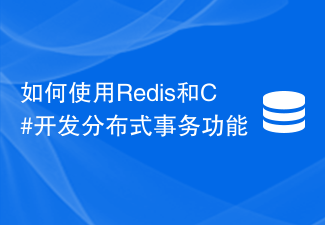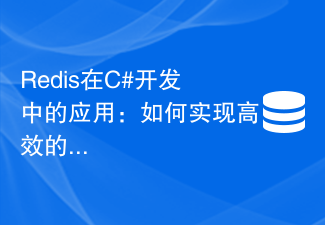Why use C# generics?
In order to understand this problem, let’s look at the following code first. The code omits some content, but the function is to implement a stack. This stack can only handle int data types:
public class Stack PRivate int[] m_item; public int Pop(){...} public void Push(int item){...} public Stack(int i) { this.m_item = new int[i]; } } run That's great, but what should we do when we need a stack to save the string type? Many people will think of copying the above code and changing the int to string. Of course, there is nothing wrong with doing this in itself, but a good program will not do this because he thinks about what to do if he needs a long or Node type stack again in the future? Do you want to copy again? Excellent programmers will think of using a common data type object to implement this stack:
public class Stack { .} public Stack(int i) . But comprehensively speaking, it is not without flaws. The main manifestations are:
When Stack handles value types, boxing and folding operations will occur, which will allocate and recycle a large number of variables on the managed heap. If the amount of data is large, The performance loss is very serious.
When processing reference types, although there are no boxing and folding operations, the data type coercion operation will be used, which increases the burden on the processor.
There are more serious problems with data type coercion (assuming stack is an instance of Stack):
Node1 x = new Node1(); Pop(); The above code is completely fine when compiling, but because a Node1 type data is pushed, but it is required to be converted to Node2 type during Pop, this will cause a type conversion exception when the program is running, but it does not work. Escapes compiler checks.
To solve the problem of object type stack, we introduce generics, which can solve these problems elegantly. Generics use a passed data type T instead of object. The type of T is specified when the class is instantiated. The runtime (Runtime) automatically compiles into local code. The operating efficiency and code quality are greatly improved, and the data type is guaranteed. Safety.
Using C# generics
The following is to use generics to rewrite the above stack, using a common data type T as a placeholder, waiting to be replaced by an actual type during instantiation. Let's take a look at the power of generic:
Public class stack {Private T [] m_item; Public T POP () {...} Public Void Push (t item) {...} Public Stack (int i) { This.m_item = new T[i]; The writing method of the class remains unchanged. It just introduces the general data type T and it can be applied to any data type and is type safe. Calling method of this class:
//Instantiation can only save classes of type int Stack a = new Stack(100); a.Push(10); a.Push("8888"); //This line does not compile because class a only receives int Type of data int x = a.Pop(); //Instantiation can only save classes of string type Stack b = new Stack(100); b.Push(10); //This line does not compile because class b Only receives string type data b.Push("8888"); string y = b.Pop(); This class is completely different from the class implemented by object:
1. It is type safe. If a stack of type int is instantiated, data of type string cannot be processed, and the same is true for other data types.
2. No need to pack and fold boxes. When this class is instantiated, local code is generated according to the data type passed in. The local code data type has been determined, so there is no need for boxing and folding.
3. No type conversion required.
Theoretical knowledge:
The so-called generics: using parameterized types to operate multiple data types on the same code. Generic programming is a programming paradigm that uses "parameterized types" to abstract types to achieve more flexible reuse.
C# generics give the code stronger type safety, better reuse, higher efficiency, and clearer constraints.
C#'s generic capabilities are supported by the CLR at runtime, which is different from C++'s compile-time template mechanism and Java's compile-time "wiping method". This allows generic capabilities to interoperate seamlessly between CLR-enabled languages.
When C# generic code is compiled into IL and metadata, special placeholders are used to represent generic types, and proprietary IL instructions are used to support generic operations. The real generic instantiation work occurs in an "on-demand" manner during JIT compilation.
The C# generic compilation mechanism is as follows:
In the first round of compilation, the compiler only generates the "generic version" of IL code and metadata for the Stack type, and does not instantiate the generic type. T is only Acts as a placeholder.
During JIT compilation, when the JIT compiler encounters Stack for the first time, it will replace T in the "generic version" IL code and metadata with the int type -- to instantiate the generic type.
CLR generates the same code for all generic types whose type parameters are "reference types", but if the type parameters are "value types", CLR will generate a separate code for each different "value type" code.
Several features of C# generics
If the parameters of the instantiated generic type are the same, the JIT compiler will reuse the type, so C#'s dynamic generics capability avoids the code bloat problem that may be caused by C++ static templates .
C# generic types carry rich metadata, so C#'s generic types can be applied to powerful reflection technology.
C#’s generics use the constraint method of “base class, interface, constructor, value type/reference type” to implement “explicit constraints” on type parameters, which improves type safety while also losing the C++ template based on “ High flexibility of implicit constraints of "signature".
When a C# generic class is compiled, the intermediate code IL is first generated, and the general type T is just a placeholder. When instantiating a class, T is replaced by the data type specified by the user and the local code is generated by the just-in-time compiler (JIT). The actual data type has been used in this local code, which is equivalent to the class written with the actual type, so it is different The native code of a closed class is different. According to this principle, we can think of it this way: different closed classes of generic classes are different data types.
In this way, generics are not only more flexible, but also improve the simplicity and simplicity of the code to a new level! No more writing specific code for different overloaded methods!
C# Generics are an invaluable asset in the development tool arsenal. They improve performance, type safety, and quality, reduce repetitive programming tasks, and simplify the overall programming model, all through an elegant, readable syntax. Although the roots of C# generics are C++ templates, C# takes generics to the next level by providing compile-time safety and support. C# takes advantage of two-phase compilation, metadata, and innovative concepts such as constraints and general methods. There is no doubt that future versions of C# will continue to evolve generics in order to add new functionality and extend generics to other .NET Framework areas such as data access or localization.
That’s a brief talk about C# generics The useful content, please pay attention to the PHP Chinese website (www.php.cn) for more related content!
 如何使用C#编写时间序列预测算法Sep 19, 2023 pm 02:33 PM
如何使用C#编写时间序列预测算法Sep 19, 2023 pm 02:33 PM如何使用C#编写时间序列预测算法时间序列预测是一种通过分析过去的数据来预测未来数据趋势的方法。它在很多领域,如金融、销售和天气预报中有广泛的应用。在本文中,我们将介绍如何使用C#编写时间序列预测算法,并附上具体的代码示例。数据准备在进行时间序列预测之前,首先需要准备好数据。一般来说,时间序列数据应该具有足够的长度,并且是按照时间顺序排列的。你可以从数据库或者
 如何使用Redis和C#开发分布式事务功能Sep 21, 2023 pm 02:55 PM
如何使用Redis和C#开发分布式事务功能Sep 21, 2023 pm 02:55 PM如何使用Redis和C#开发分布式事务功能引言分布式系统的开发中,事务处理是一项非常重要的功能。事务处理能够保证在分布式系统中的一系列操作要么全部成功,要么全部回滚。Redis是一种高性能的键值存储数据库,而C#是一种广泛应用于开发分布式系统的编程语言。本文将介绍如何使用Redis和C#来实现分布式事务功能,并提供具体代码示例。I.Redis事务Redis
 如何实现C#中的人脸识别算法Sep 19, 2023 am 08:57 AM
如何实现C#中的人脸识别算法Sep 19, 2023 am 08:57 AM如何实现C#中的人脸识别算法人脸识别算法是计算机视觉领域中的一个重要研究方向,它可以用于识别和验证人脸,广泛应用于安全监控、人脸支付、人脸解锁等领域。在本文中,我们将介绍如何使用C#来实现人脸识别算法,并提供具体的代码示例。实现人脸识别算法的第一步是获取图像数据。在C#中,我们可以使用EmguCV库(OpenCV的C#封装)来处理图像。首先,我们需要在项目
 如何使用C#编写动态规划算法Sep 20, 2023 pm 04:03 PM
如何使用C#编写动态规划算法Sep 20, 2023 pm 04:03 PM如何使用C#编写动态规划算法摘要:动态规划是求解最优化问题的一种常用算法,适用于多种场景。本文将介绍如何使用C#编写动态规划算法,并提供具体的代码示例。一、什么是动态规划算法动态规划(DynamicProgramming,简称DP)是一种用来求解具有重叠子问题和最优子结构性质的问题的算法思想。动态规划将问题分解成若干个子问题来求解,通过记录每个子问题的解,
 Redis在C#开发中的应用:如何实现高效的缓存更新Jul 30, 2023 am 09:46 AM
Redis在C#开发中的应用:如何实现高效的缓存更新Jul 30, 2023 am 09:46 AMRedis在C#开发中的应用:如何实现高效的缓存更新引言:在Web开发中,缓存是提高系统性能的常用手段之一。而Redis作为一款高性能的Key-Value存储系统,能够提供快速的缓存操作,为我们的应用带来了不少便利。本文将介绍如何在C#开发中使用Redis,实现高效的缓存更新。Redis的安装与配置在开始之前,我们需要先安装Redis并进行相应的配置。你可以
 C#开发中如何处理跨域请求和安全性问题Oct 08, 2023 pm 09:21 PM
C#开发中如何处理跨域请求和安全性问题Oct 08, 2023 pm 09:21 PMC#开发中如何处理跨域请求和安全性问题在现代的网络应用开发中,跨域请求和安全性问题是开发人员经常面临的挑战。为了提供更好的用户体验和功能,应用程序经常需要与其他域或服务器进行交互。然而,浏览器的同源策略导致了这些跨域请求被阻止,因此需要采取一些措施来处理跨域请求。同时,为了保证数据的安全性,开发人员还需要考虑一些安全性问题。本文将探讨C#开发中如何处理跨域请
 如何实现C#中的图像压缩算法Sep 19, 2023 pm 02:12 PM
如何实现C#中的图像压缩算法Sep 19, 2023 pm 02:12 PM如何实现C#中的图像压缩算法摘要:图像压缩是图像处理领域中的一个重要研究方向,本文将介绍在C#中实现图像压缩的算法,并给出相应的代码示例。引言:随着数字图像的广泛应用,图像压缩成为了图像处理中的重要环节。压缩能够减小存储空间和传输带宽,并能提高图像处理的效率。在C#语言中,我们可以通过使用各种图像压缩算法来实现对图像的压缩。本文将介绍两种常见的图像压缩算法:
 如何实现C#中的遗传算法Sep 19, 2023 pm 01:07 PM
如何实现C#中的遗传算法Sep 19, 2023 pm 01:07 PM如何在C#中实现遗传算法引言:遗传算法是一种模拟自然选择和基因遗传机制的优化算法,其主要思想是通过模拟生物进化的过程来搜索最优解。在计算机科学领域,遗传算法被广泛应用于优化问题的解决,例如机器学习、参数优化、组合优化等。本文将介绍如何在C#中实现遗传算法,并提供具体的代码示例。一、遗传算法的基本原理遗传算法通过使用编码表示解空间中的候选解,并利用选择、交叉和


Hot AI Tools

Undresser.AI Undress
AI-powered app for creating realistic nude photos

AI Clothes Remover
Online AI tool for removing clothes from photos.

Undress AI Tool
Undress images for free

Clothoff.io
AI clothes remover

AI Hentai Generator
Generate AI Hentai for free.

Hot Article

Hot Tools

Dreamweaver CS6
Visual web development tools

SecLists
SecLists is the ultimate security tester's companion. It is a collection of various types of lists that are frequently used during security assessments, all in one place. SecLists helps make security testing more efficient and productive by conveniently providing all the lists a security tester might need. List types include usernames, passwords, URLs, fuzzing payloads, sensitive data patterns, web shells, and more. The tester can simply pull this repository onto a new test machine and he will have access to every type of list he needs.

MantisBT
Mantis is an easy-to-deploy web-based defect tracking tool designed to aid in product defect tracking. It requires PHP, MySQL and a web server. Check out our demo and hosting services.

mPDF
mPDF is a PHP library that can generate PDF files from UTF-8 encoded HTML. The original author, Ian Back, wrote mPDF to output PDF files "on the fly" from his website and handle different languages. It is slower than original scripts like HTML2FPDF and produces larger files when using Unicode fonts, but supports CSS styles etc. and has a lot of enhancements. Supports almost all languages, including RTL (Arabic and Hebrew) and CJK (Chinese, Japanese and Korean). Supports nested block-level elements (such as P, DIV),

ZendStudio 13.5.1 Mac
Powerful PHP integrated development environment






